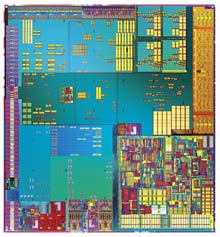Intel’s New Breed of Chips
Intel has long dominated the market for personal-computer and server chips, but as sales of these components decline, the Santa Clara, CA, company is hoping to get a better toehold in new markets, particularly those for smart phones, netbooks, and other mobile Internet devices. To do this, Intel is exploring system-on-chip (SoC) designs–complex microchips that perform specialized tasks on top of general-purpose computations.

Future SoC hardware will be less power hungry and capable of doing graphics processing, complex wireless communication, and on-chip temperature sensing, as well as general number crunching and memory management.
Today, Intel gave a preview of several papers that its researchers will present at the International Solid State Circuits Conference in San Francisco next week, including some revealing new SoC designs. Among the SoC designs disclosed are ones featuring wireless radios capable of using several different communications standards and operating at high speeds, integrated graphics processors for mobile devices that are many times more efficient than those used in desktop machines, and built-in sensors that track critical conditions on a chip itself.
Over the past few decades, Intel has fulfilled the prediction of its founder, Gordon Moore: that the number of transistors on a chip will double roughly every two years. With these new designs, the chip maker is turning its attention to adding much complexity to its chips as well. Components on these next-generation chips will be as small as just 32 nanometers.
“This is a new era of scaling in an SoC world,” says Mark Bohr, an Intel Senior Fellow. “As you reduce the size of transistors, the price per transistor goes down. It enables unprecedented complexity as we scale down to 32 nanometers.”
Last July, Intel announced plans to build several types of SoC components based on an existing processor design, called Intel architecture. The company has more than 15 SoC projects planned, including a chip code-named Canmore that will integrate computing, graphics, and audio-video capabilities for portable devices and is scheduled to debut later this year.
At next week’s conference, Intel researchers will also present work on chips that will most likely hit the market in three to five years, says Soumyanath Krishnamurthy, an Intel Fellow. One paper details an SoC featuring a new type of digital wireless radio that operates over a number of standards, including Wi-Fi, WiMax, and cellular-phone frequencies. One of the problems with this type of radio design, Krishnamurthy explains, is producing a clear signal. Without providing specific details, he says that Intel researchers have found a way to leverage the slight variations in silicon processing techniques to improve the radio signals.
Intel is working on another SoC radio that operates in the 60-gigahertz range–a range for which no standards yet exist. At this frequency, the device could send and receive wireless data rates of up to three gigabits per second, Krishnamurthy says. This would make the platform ideal for streaming high-quality video and instantly syncing a collection of computers, mobile phones, and other gadgets.
Another paper that will be presented at the conference details an energy-saving graphics processor targeted at mobile devices. It processes multiple pixels at once–something that only power-hungry desktop chips are capable of today. Krishnamurthy says, “We want to bring this capability to mobile devices and make them in our next gen of SoC.” He adds that traditional techniques don’t work well at low voltages, but Intel engineers tweaked the design to drastically reduce the voltage required.
About an on-chip digital temperature sensor, Krishnamurthy says, “We’d like to be able to sense what’s going on at various spots on the die.” This is important because certain parts of the chip heat up faster than others do. A future chip could be smart enough to off-load some tasks to different parts of the chip so that it doesn’t suffer heat damage.
Tom Halfhill, an analyst at research firm In-stat, says it is not surprising that Intel wants to enter the market for smaller mobile computers with its own SoC architectures, given the growth that it has seen in recent years. “You’re seeing a second generation of personal computers: smart phones, netbooks, and these mobile Internet devices–personal computers you carry on your person,” he says. “That’s where the growth market will be in the future, and that’s where Intel hasn’t traditionally had good solutions.”
Halfill says that Intel will need to catch up quickly with ARM, which supplies chips to the majority of the mobile market. “Intel is late to the game in some cases,” he says. “ARM was the first for low-power, embedded chips.”
But Krishnamurthy is optimistic about Intel’s chances of taking the lead. “We see no show stoppers as we proceed with our goals,” he says.
Keep Reading
Most Popular
Large language models can do jaw-dropping things. But nobody knows exactly why.
And that's a problem. Figuring it out is one of the biggest scientific puzzles of our time and a crucial step towards controlling more powerful future models.
The problem with plug-in hybrids? Their drivers.
Plug-in hybrids are often sold as a transition to EVs, but new data from Europe shows we’re still underestimating the emissions they produce.
Google DeepMind’s new generative model makes Super Mario–like games from scratch
Genie learns how to control games by watching hours and hours of video. It could help train next-gen robots too.
How scientists traced a mysterious covid case back to six toilets
When wastewater surveillance turns into a hunt for a single infected individual, the ethics get tricky.
Stay connected
Get the latest updates from
MIT Technology Review
Discover special offers, top stories, upcoming events, and more.